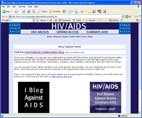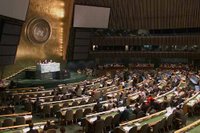Last year, in his progress report on the implementation of the UNGASS Declaration of Commitment on HIV/AIDS, the UN Secretary General said:
"Civil society is playing an increasingly valuable role in monitoring the fulfilment of these commitments."

UNAIDS requested governments to submit progress reports on DoC implementation by the end of last year - and despite repeated requests, government reports have not yet been made publicly available by UNAIDS. Contrary to Kofi Annan's hopes, denying access to the basic information and assessments of national government 'progess' seriously undermines any meaningful involvement by civil society.
Please consider adding your signature to the statement below, which strongly urges UNAIDS to make this crucial information available and help ensure meaningful participation of civil society in the UNGASS review process.
If you would like to add your name to the list of statement signatories, please send an email NOW to:
ungasshiv@gmail.comThe final statement will be compiled and sent to UNAIDS on Thursday 30th March 2006.
Many thanks for your support,
(For
Civil Society Coalition on HIV/AIDS UNGASS)
Joint Statement to UNAIDS
As the date of the UN General Assembly’s high-level review of progress on implementation of the 2001 “Declaration of Commitment on HIV/AIDS” (Doc) draws closer (31 May – 2 June, 2006), we wish to raise an urgent issue that demands immediate attention.
UNAIDS requested governments to submit progress reports on DoC implementation by December 31st, 2005 (later extended to January 31st, 2006). At the same time, over 25 civil society organizations presented UNAIDS with independently-researched national “shadow reports”, and have shared these findings with each other, with their governments and with the broader public (see www.ungasshiv.org).
Unfortunately, despite our repeated requests, government reports have not yet been made publicly available by UNAIDS. Without public access to governments’ official assessments of their progress, it is not possible for civil society groups to comment, respond, and offer alternative assessments and perspectives at the high-level review. We are certain you will agree that civil society groups have different and equally valuable perspectives to governments – perspectives which will add immeasurably to the discussion and debate at the high-level review.
The DoC urges the involvement of civil society as an equal partner at all levels of policy-making, implementation and monitoring and evaluation (DoC: p32-33; 94-103). To fulfill this critical aspect of the DoC, it is clear that transparent policy-making processes and access to critical information are essential. In the interest of preserving the credibility and legitimacy of the high-level review meeting, please let us know when and how UNAIDS plans to make available both the government progress reports it has received and its “global progress report.” We would also request a full accounting of which governments have reported on DoC implementation as requested, and which have not. We trust that these requests can be met well in advance of the high-level meeting.
With thanks for your continued support for strong civil society participation in the UNGASS HIV/AIDS high-level review.
PostscriptBy the time this letter was sent to UNAIDS on April 3 2006, it was signed by all of the people listed below. Three days later, on 7 April 2006, UNAIDS capitulated and published all national UNGASS reports on their website. They are now available
here.
Signatory Organisations:African Services Committee (Kim Nicols)
AIDS Care Watch (Abigail Eirkson)
AIDS and Rights Alliance for Southern Africa (Michaela Clayton)
Associacao Mulher, Lei e Desenvolvimento (MULEIDE; Rafa Valente Machava)
Center for Health and Gender Equity (CHANGE) (Healy Thompson)
Center for Women's Global Leadership (Sara Nordstrom)
CHOICE, for youth and sexuality (Anneke Wensing)
Coordinadora Peruana de PVVS (Pablo Anamaria)
EATG, European AIDS Treatment Group, (Wim Vandevelde)
Egyptian Initative for Personal Rights (Hossam Bahgat)
Ecuadorian Coalition of PLWHA (Dario Abarca)
Family Care International (Shannon Kowalski-Morton)
Foresight Generation Club (Albert Yeboah Obeng)
Fundación Apoyo y Solidaridad de Cali- Colombia (Oswaldo Adolfo Rada)
Grupo Português de Activistas sobre Tratamentos de VIH/SIDA (GAT; Wim Vandevelde)
German Foundation for World Population (DSW; Karen Hoehn)
Health & Development Networks (Tim France)
International Women's Health Coalition (Zonibel Woods)
Marie Stopes International (Joyce Haarbrink)
NEPWHAN (Pat O Matemilola)
No Limit For Women
Fundación en Acción, Revista INdetectable (Luís Augusto Rivera)
Progressive Organization of Gays in the Philippines (Edgar Atadero)
Public Services International (Alan Leather)
Red Latinoamericana de Personas que viven con Vih - Sida (REDLA+; Oswaldo Adolfo Rada)
Russian Harm Reduction Network (Vitaly Djuma)
Southern African Network of AIDS Service Organizations (SANASO; Farai Mugweni)
Students Partnership Worldwide (Fionnuala Murphy)
Tearfund (Richard Weaver)
The John Mordaunt Trust (Andria)
Treatment Action Group (TAG; Mark Harrington)
Voluntary Services Overseas (VSO; Samantha Willan)
World AIDS Campaign (Marcel van Soest)
World Population Foundation (Yvonne Bogaarts)
Individuals:
Philip Abraham, Chief Consultant, PA Development Consultants, India
K. K. Abraham, President, Indian Network for People living with HIV/AIDS (INP+)
Albert Adalsteinsson, Iceland
Atiq Adil Shah, AMAL Pakistan
Bright O Aleruchi
Dennis Altman, Professor of Politics, LaTrobe University, Australia
Sam Anyimadu-Amaning, Ghana HIV/AIDS Network
Rita Arauz Molina, Presidenta, The Global Fund for AIDS, TB and Malaria
Luís Augusto Rivera, Director del Área Social, Mauricio Sarmiento Casallas y Rafael Sandoval Arévalo, Colombia
Sunil B Pant, Director, Blue Diamond Society, Nepal
Sumita Banerjee, Program Officer, International Council of AIDS Service Organizations, Canada
Murdo Bijl, Health Connections International, The Netherlands
María Bilbao Nogueira
Cecilia Blankson, chairperson, GHANET Western Region Chapter, Ghana
Rosa Borja Borja, Peru
Saira Carina Ortega, Coordinadora Area de Prevención ITS/VIH/SIDA, Asociación de Salud Integral
Estela Carrizo, Grupo de Apoyo, Red Latinoaméricana de Personas Viviendo con vih/sida (RedLa+), Argentina
Estela Carrizo, Coalición Internacional de Activistas en Tratamiento (CIAT)
Lic. Julio Cesar Aguilera, Director Fundación REDVIHDA, Miembro de la REDBOL (Red Nacional de PWS de Bolivia)
Birungi Charles, HIV/AIDS Focal Point of Hoima Catholic Diocese, Uganda
Blessing Chataira, Zimbabwe
Enrique Chavez, Advocacy Director, AID FOR AIDS International, United States
Oge Chibueze-Ukaegbu
Ngoni Chibukire, Senior Regional Programme Officer (SRPO), Southern Africa HIV/AIDS Information Dissemination Service, Zimbabwe
Susan Chong, Asia Pacific Council of AIDS Service Organisations (APCASO), Malaysia
Sarah Chynoweth
Chris Collins, United States
Lena Corina Valencia, Peru
Mary Corkery, Executive Director, KAIROS: Canadian Ecumenical Justice Initiatives/Initiatives canadiennes oecumeniques pour la justice, Canada
Joanne Csete, Executive Director, Canadian HIV/AIDS Legal Network
Delme Cupido, AIDS Law Unit, Legal Assistance Centre, Namibia
Pablo Cymerman, Intercambios Asociación Civil, Argentina
Kevin Dance CP, Passionists International, United States
Theresa de Necker, Managing Director, Vusi Sizwe Holdings (Pty) Ltd, South Africa
Belletech Deressa
Franck DeRose, Executive Director, The Condom Project, United States
Christoph E. Mann, Ecumenical HIV/AIDS Initiative in Africa, Switzerland
Begonia Elizalde Nunez, Peru
Betty Escobar, AID FOR AIDS Venezuela
Cecibel Estuat Geldres, Peru
Sabir Farhat, Secretary General, AIDS Prevention Society of Pakistan (APSOP), Pakistan
Bernard Forbes, Chair, UK Coalition of People Living with HIV and AIDS, United Kingdom
Jessie Forsyth, Linkage Program, Mozambique
Nadia Fringer, International AIDS Vaccine Initiative
Diego Garcia Morcillo, casmu, Spain
Olaide Gbadamosi, Executive Director, Network for Justice and Democracy, Nigeria
Alicia Gibbs, Caritas Australia, Australia
Alejandra Gil, Directora de APROASE A,C, Organización de Trabajadoras Sexuales de México
Francoise Girard, Director, Network Public Health Program, Open Society Institute, United States
Gregg Gonsalves, United States
Anna Gorter, Instituto CentroAmericano de la Salud, Nicaragua
Rachel Guglielmo, Project Director, Public Health Watch Open Society Institute, United States
Rana Gulzar, AMAL Pakistan
Sergio Guzmán, Representante de las ONGs con Servicio en VIH/SIDA de la Provincia, Venezuela
Linda Hartke, Coordinator, Ecumenical Advocacy Alliance, Switzerland
Jamie Isbister, Caritas Australia,
Mobasharul Islam, HIV Program
Mpiima Jamir Ssenoga, General Secretary, AIDS Alert Uganda
Sherine Jayawickrama
Iva Jovovic, Executive Director, NGO LET/FLIGHT, Croatia
Nelson Juma Otwoma, AMREF, Kenya
Bertrand Kampoer, Coordinator, FISS-MST/SIDA, Cameroon
Rama Kant, Professor, Department of Surgery, King George's Medical University and Gandhi Memorial & Associated Hospitals, India
Ronald Kayanja, Director, Panos Global AIDS Programme, Zambia
Appaih Kwaku Boateng, Executive Director, Ghana
Carole Leach-Lemens, United States
Cath Leary, Caritas Australia, Australia
Flor Lemundo, Peru
Lídice López Tocón, Colectivo por la Vida, Peru
Amanda Lugg, African Services Committee, United States
Lois B Lunga, Executive Director, Southern Africa HIV/AIDS Information Dissemination Service, Zimbabwe
Ian Mashingaidze, Country Programme Manager, ActionAid International Zimbabwe
Justine McMahon, Caritas, Australia
Shaun Mellors, Activist, South Africa
John Mihevc, Team Leader, KAIROS: Canadian Ecumenical Justice Initiatives/Initiatives canadiennes oecumeniques pour la justice, Canada
Sakanga Mourouba Rene, National Coordinator, HIV/AIDS National NGOs Network, Central African Republic
Godfrey Mungazi
Michelle Munro, Programme Director, HIV/AIDS and Health, CARE Canada
Josephine Murphy, Coordinator, Youth Community Training Centre, Zambia
Joe Muwonge, Senior Policy Advisor, World Vision Partnership, United States
Danny Mwitanti, Health for Africa
Gopakumar Nair, HIV/AIDS Policy and Programme Adviser, Save the Children UK
Abid Naqvi, AMAL Pakistan
Digambar Narzary, India
Louise Nash, Health & Development Networks
George Ndukwu, The Condom Project, Nigeria
Lucy Ng'ang'a, EANNASO, Tanzania
Alessandra Nilo, Diretora Presidente, Gestos - Soropositividade Comunicação e Genero, Brazil
Elena Obieta, Clinician, Argentina
Tinu Odugbemi, Head High International, Nigeria
Ibekwe Ogochukwu, Pro National Youth Network On HIV/AIDS, Anambra State, Nigeria
Rachel Ong, APN+ Advisor, PCB NGO Main Delegate for Asia & Pacific
Lisandro Orlov, Pastoral Ecumenica VIH/SIDA
William Oscar Fleming, HIV/AIDS Program Specialist, United States
Jirapan Panwang
Federico Parodi, Presidente, Red de Personas Viviendo con vih/sida, Argentina
Ericka Pastor Asencios, Peru
David Patterson, Instituto CentroAmericano de la Salud, Canada
Noris Pignata, Argentina
Nigel Pounde, HIV/AIDS Project Co-ordinator, Church of Scotland, Scotland
Carlos Quintero Saéz, Diréctor Ejecutivo, Acción Solidaria, Venezuela
Saloman R Jeldi, President & CEO, Strides Society, India
Allan Ragi, Executive Director, Kenya AIDS NGOs Consortium (KANCO), Kenya
Razahussnain, AMAL Pakistan
Margaret Rice, Caritas Australia,
Germán Humberto Rincón Pertti, Asociación Líderes en Acción, Colombia
Imran Rizvi, AMAL Pakistan
Nighat Rizvi, AMAL Pakistan
Sonia Rojas Camargo, Peru
Katja Roll, Political Coordinator, Action Against AIDS Germany
Francisco Rosas, Mexico
Mindy Jane Roseman, J.D., Academic Director, Harvard Law School, United States
Catherine Rowan, Corporate Responsibility Coordinator, Maryknoll Sisters, United States
John Ryan, Chief Executive Officer, Association for Prevention and Harm Reduction Programs Australia, Australia
Arati Samajpati, NGO Parivartan, India
Laura Scully
Renu Seth, India
Rainer Seybold, Projektkoordination, Finanzen und Vernetzung, Aktionsbündnis gegen AIDS, Germany
Faisal Shafik, AMAL Pakistan
Aditi Sharma, International HIV&AIDS Campaign Coordinator, ActionAid International, United Kingdom
Ursula Sharpe, Medical Missionaries of Mary, Ireland
Bhagawan Shrestha, The Netherlands
Sheila Shyamprasad, Consultant for HIV/AIDS Program and Projects, Department for Mission and Development, The Lutheran World Federation, Switzerland
Garet Sibanda, Zimbabwe
Saraswati Singh
Caroline Sirewu
Simon Stroud, Caritas, Australia
Miriam Stucchi Malpartida, Peru
Amie Tallow
Bakary Tandia
Pascal Tanguay, Information Officer, Asian Harm Reduction Network (AHRN), Thailand
Ted Taziveyi, African Health Promotion Officer, Terrence Higgins Trust, United States
Martha Tholanah, Programme Manager for Health, Gays and Lesbians of Zimbabwe (GALZ), Zimbabwe
Saima Toor, AMAL Pakistan
Sajjida Toor, AMAL Pakistan
Jamie Uhrig, Thailand
Roy Unge
Joost van der Meer, Executive Director, AIDS Foundation East-West (AFEW), Russia
Pieter van Gylswyk, Programme Officer, Diakonia Regional Office for Southern Africa, South Africa
Barry Van Wyk
Paulo Vieira, YouAct - European Youth Network on Sexual and Reproductive Rights, Portugal
Vianca Vilcahuaman Vilcamiche, Peru
Ahoefa Vovor, Caritas Africa
Asunta Wagura, Executive Director, Kenya Network of Women with AIDS (KENWA)
David Roger J. Walugembe, Information Scientist, Ministry of Public Service, Uganda
Sonja Weinreich, German Institute for Medical Mission (Difaem)
Patricia Weisenfeld, Asia Regional Program Manager, The Female Health Foundation, Thailand
Wayne Wiebel, University of Illinois at Chicago, United States
Mohammad Ziaul Ahsan, Organization for Social Development of Unemployed Youth










